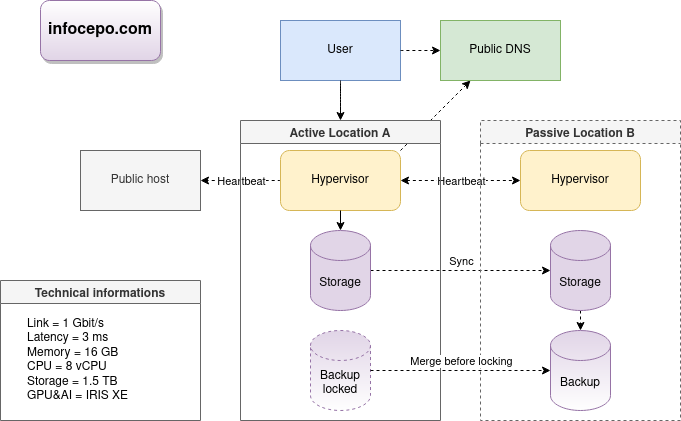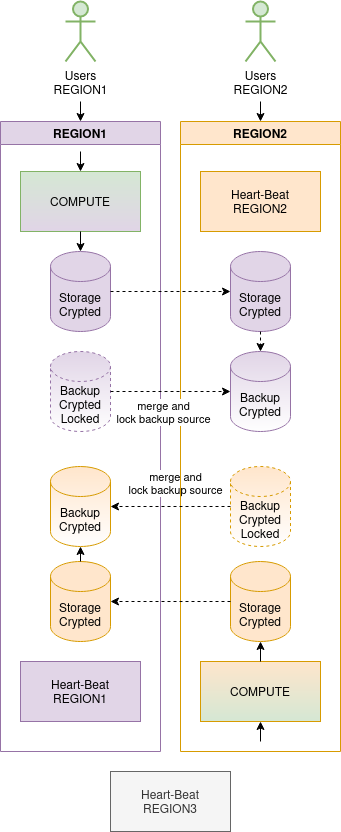Main Page
Jump to navigation
Jump to search
Welcome to my WIKI.
It explores cloud computing, focusing on migration, infrastructure, and high availability. It discusses tools like Kubernetes, OpenStack, AWS, emphasizes open-source software, and outlines key factors for cloud infrastructure implementation.
AI Solutions
- Science Research Tool - AI for science.
- Platform - AI-powered design.
Next Steps
- LANGCHAIN - Upcoming semantic tool.
- VICUNA (LLAMA) - Open-source AI chat.
POCs
- AUDIO - Real-time translation.
- Auto-GPT - AI for coding.
- OpenAI's AI Tools - Industry-transforming AI.
- Benchmark - AI performance standard.
CLOUD LAB
Presenting my LAB project.

Infrastructure Audit
Created ServerDiff.sh for server audits. Enables configuration drift tracking and environment consistency checks.
Cloud Migration Example
- 1.5d: Infrastructure audit of 82 services (ServerDiff.sh)
- 1.5d: Create cloud architecture diagram
- 1.5d: Compliance check of 2 clouds (6 hypervisors, 6TB memory)
- 1d: Cloud installations
- .5d: Stability check
| ACTION | RESULT | OK/KO |
| Activate maintenance for n/2-1 nodes or 1 node if 2 nodes. | All resources are started. | |
| Un-maintenance all nodes. Power off n/2-1 nodes or 1 node if 2 nodes, different from the previous test. | All resources are started. | |
| Power off simultaneous all nodes. Power on simultaneous all nodes. | All resources are started. |
- 1.5d: Cloud automation study
- 1.5d: Develop 6 templates (2 clouds, 2 OS, 8 environments, 2 versions)
- 1d: Create migration diagram
- 1.5d: Write 138 lines of migration code (MigrationApp.sh)
- 1.5d: Process stabilization
- 1.5d: Cloud vs old infrastructure benchmark
- .5d: Unavailability time calibration per migration unit
- 5min: Load 82 VMs (env, os, application_code, 2 IP)
Total = 15 man-days
Cloud Enhancement
- Formalize infrastructure for flexibility and reduced complexity.
- Utilize customer-location tracking name server like GDNS.
- Use minimal instances with a network load balancer like LVS.
- Compare prices of dynamic computing services, beware of tech lock-in.
- Employ efficient frontend TLS decoder like HAPROXY.
- Opt for fast HTTP cache like VARNISH and Apache Traffic Server for large files.
- Use REVERSE PROXY with TLS decoder like ENVOY for service compatibility.
- Consider serverless service for standard runtimes, mindful of potential incompatibilities.
- Employ load balancing or native services for dynamic computing power.
- Use open source STACKs where possible.
- Employ database caches like MEMCACHED.
- More information at CLOUD WIKIPEDIA.
CLOUD WIKIPEDIA
CLOUD vs HW
| Function | KUBERNETES | OPENSTACK | AWS | Bare-metal | HPC | CRM | OVIRT |
|---|---|---|---|---|---|---|---|
| DEPLOY | HELM/ANSIBLE/SH | TERRAFORM/ANSIBLE/SH/JUJU | TERRAFORM/CLOUDFORMATION/ANSIBLE/JUJU | ANSIBLE/SH | XCAT/CLUSH | ANSIBLE/SH | ANSIBLE/PYTHON/SH |
| BOOTSTRAP | API/CLI | PXE/API/CLI | API/CLI | PXE/IPMI | PXE/IPMI | PXE/IPMI | PXE/API |
| Router | API/CLI (kube-router) | API/CLI (router/subnet) | API/CLI (Route table/subnet) | LINUX/OVS/external | XCAT/external | LINUX/external | API |
| Firewall | INGRESS/EGRESS/ISTIO | API/CLI (Security groups) | API/CLI (Security group) | LINUX (NFT) | LINUX (NFT) | LINUX (NFT) | API |
| Vlan/Vxlan | many | API/CLI (VPC) | API/CLI (VPC) | OVS/LINUX/external | XCAT/external | LINUX/external | API |
| Name server | coredns | dns-nameserver | Amazon Route 53 | GDNS | XCAT | LINUX/external | API/external |
| Load balancer | kube-proxy/LVS(IPVS) | LVS | Network Load Balancer | LVS | SLURM | Ldirectord | |
| Storage | many | SWIFT/CINDER/NOVA | S3/EFS/FSX/EBS | OPENSTACK SWIFT/XFS/EXT4/RAID10 | GPFS | SAN | NFS/SAN |
CLOUD providers
CLOUD INTERNET NETWORK
CLOUD NATIVE
HA COROSYNC+PACEMAKER
Typical architecture
- 2 rooms
- 2 power supply
- 2FC / server (active/active) (SAN)
- 2*10Gbit/s ethernet / server (active/passive, possible active/active if PXE on native VLAN 0)
- IPMI VLAN (for the fence)
- VLAN ADMIN which must be the native VLAN if BOOTSTRAP by PXE (admin, provisioning, heartbeat)
- USER VLAN (application services)
- NTP
- DNS+DHCP+PXE+TFTP+HTTP for auto-provisioning
- PROXY (for update or otherwise internal REPOSITORY)
- Choose between 2 or more node clusters.
- For a 2-node architecture, you need a 2-node configuration on COROSYNC and make sure to configure a 10-second staggered closing for one of the nodes (otherwise, an unstable cluster results).
- Resources are stateless.
For DB resources it is necessary to provide 4GB per base in general. For CPU resources, as a rule there are no big requirements. Tip, for time-critical compressions, use PZSTD.
Typical service pattern
- MULTIPATH
- LUN
- LVM (LVM resource)
- FS (FS resource)
- NFS (FS resource)
- USER
- IP (IP resource)
- DNS name
- PROCESS (PROCESS resource)
- LISTENER (LISTENER resource)



